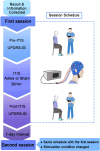Transcranial Temporal Interference Stimulation of the Right Globus Pallidus in Parkinson's Disease
- PMID: 39133053
- PMCID: PMC12160976
- DOI: 10.1002/mds.29967
Transcranial Temporal Interference Stimulation of the Right Globus Pallidus in Parkinson's Disease
Abstract
Background: Invasive deep brain stimulation (DBS) has been shown to be effective in treating patients with Parkinson's disease (PD), yet its clinical use is limited to patients at the advanced stage of the disease. Transcranial temporal interference stimulation (tTIS) may be a novel nonneurosurgical and safer alternative, yet its therapeutic potential remains unexplored.
Objective: This pilot study aims to examine the feasibility and safety of tTIS targeting the right globus pallidus internus (GPi) for motor symptoms in patients with PD.
Methods: Twelve participants with mild PD completed this randomized, double-blind, and sham-controlled experiment. Each of them received either 20-minute or sham tTIS of the right GPi. Before and immediately after the stimulation, participants completed the Movement Disorder Society-Unified Parkinson's Disease Rating Scale (MDS-UPDRS-III) in the "medication-on" state to assess the motor symptoms. The blinding efficacy and side effects were also assessed.
Results: tTIS was well tolerated by participants, with only mild, transient adverse effects reported. tTIS significantly reduced MDS-UPDRS-III scores by 6.64 points (14.7%), particularly in bradykinesia (23.5%) and tremor (15.3%). The left side showed more significant alleviation in motor symptoms, particularly bradykinesia, compared to the right side. Participants with severer bradykinesia and tremor before stimulation experienced greater improvement after tTIS.
Conclusion: This pilot study suggests that the tTIS, as a novel noninvasive DBS approach, is feasible and safe for alleviating motor symptoms in mild PD, especially bradykinesia and tremor. Future larger-scale and more definitive studies are needed to confirm the benefits. © 2024 The Author(s). Movement Disorders published by Wiley Periodicals LLC on behalf of International Parkinson and Movement Disorder Society.
Keywords: Parkinson's disease; globus pallidus internus; motor symptoms; noninvasive deep brain stimulation; temporal interference stimulation.
© 2024 The Author(s). Movement Disorders published by Wiley Periodicals LLC on behalf of International Parkinson and Movement Disorder Society.
Figures




References
-
- Jankovic J. Parkinson's disease: clinical features and diagnosis. J Neurol Neurosurg Psychiatry 2008;79(4):368–376. - PubMed
-
- Deuschl G, Schade‐Brittinger C, Krack P, et al. A randomized trial of deep‐brain stimulation for Parkinson's disease. N Engl J Med 2006;355(9):896–908. - PubMed
-
- McGregor MM, Nelson AB. Circuit mechanisms of Parkinson's disease. Neuron 2019;101(6):1042–1056. - PubMed
-
- Follett KA, Weaver FM, Stern M, et al. Pallidal versus subthalamic deep‐brain stimulation for Parkinson's disease. N Engl J Med 2010;362(22):2077–2091. - PubMed
Publication types
MeSH terms
Grants and funding
LinkOut - more resources
Full Text Sources
Medical
Research Materials
Miscellaneous

